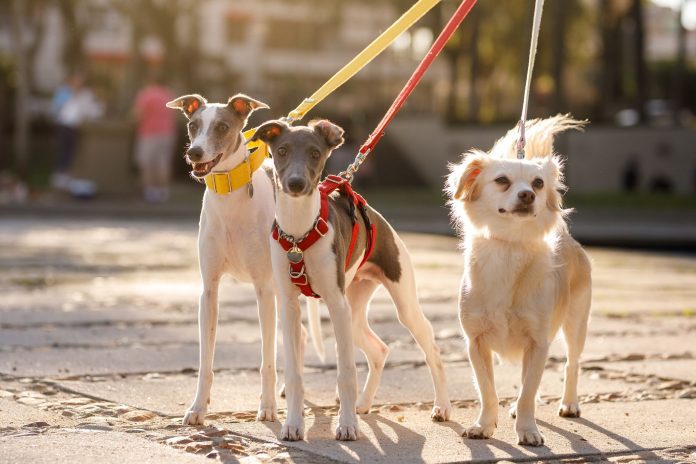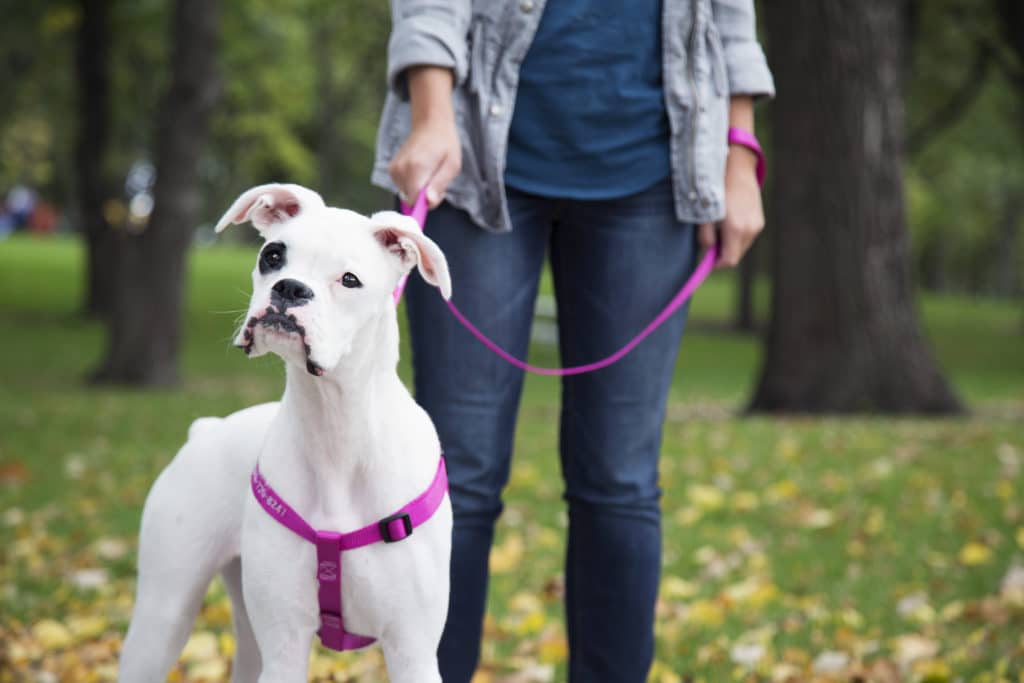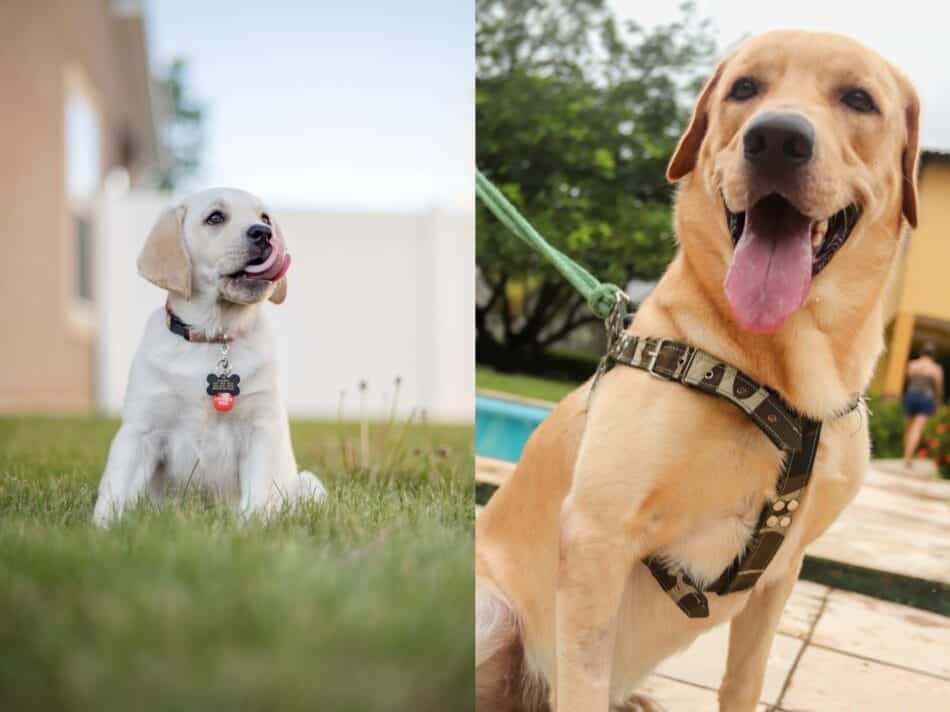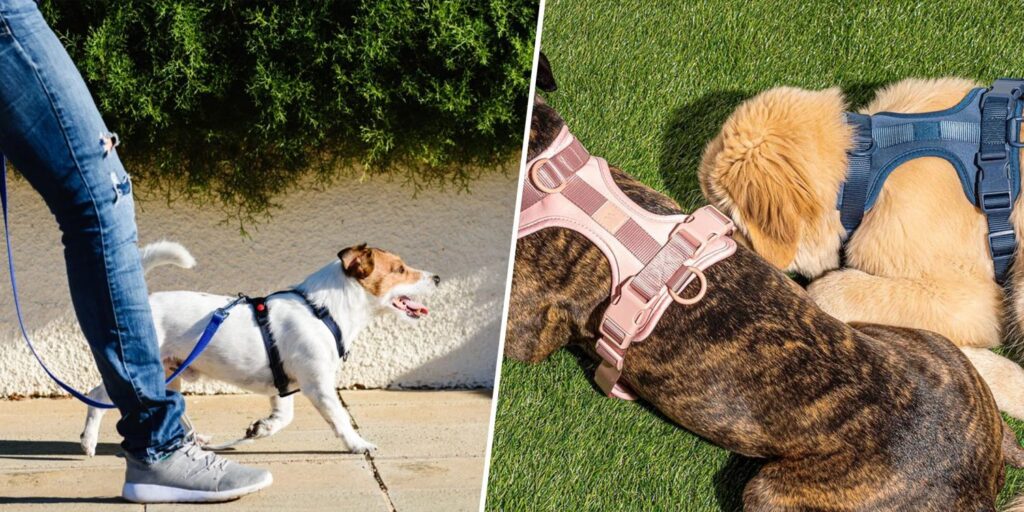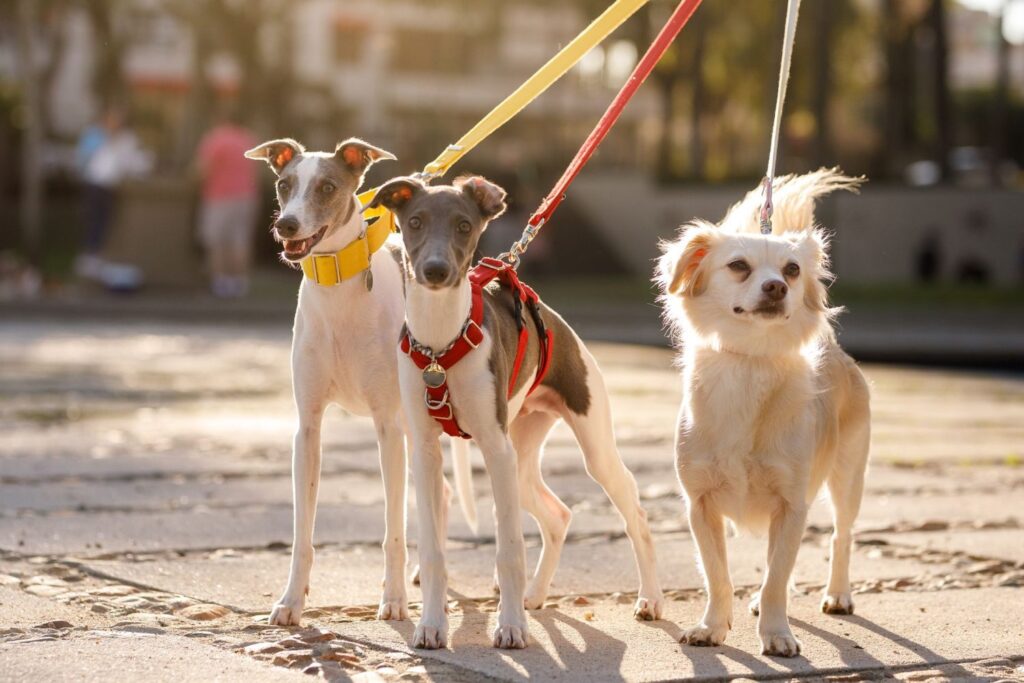If you’re a dog owner, you’ve probably wondered how to take your furry friend for a walk. Should you use a collar or a harness?
While collars have been the go-to choice for many years, there’s a growing debate about the benefits of harnesses for dogs.
This article will explore whether you should always walk your dog in a harness, examining the advantages of this alternative method and providing helpful tips for making the right choice for you and your beloved pet.
Benefits of Walking a Dog in a Harness
Walking your dog in a harness offers various benefits for both you and your furry friend. Here are some of the primary advantages:
Safety
Using a dog harness provides an added layer of safety during your walks. Unlike traditional collars, harnesses distribute the force evenly across the chest and shoulders, reducing the risk of injury to your dog’s neck and throat. This is especially beneficial for dogs prone to respiratory issues or breeds with delicate neck structures.
Better control
Walking a dog in a harness gives you better control over their movements, especially for larger or more energetic dogs. The harness design allows you to have a more secure grip and enables you to guide your dog without straining your arm or wrist. This control is particularly useful when encountering distractions or in situations that require immediate restraint.
Reduced strain on the neck and throat
Some dogs naturally pull during walks, which can lead to discomfort and injury. With a harness, the pressure is distributed across the body, primarily on the chest and shoulders, reducing strain on the neck and throat. By preventing excessive pulling, a harness can help alleviate the risk of tracheal damage or discomfort in your dog.
Prevents pulling
Walking a dog that tends to pull can be a challenge. Fortunately, using a harness can help address this issue. Harnesses, especially those with front-clip or no-pull designs, discourage pulling behaviors by redirecting the dog’s attention toward you when they pull. This redirection helps establish better walking habits and makes walking more enjoyable for you and your pup.
Comfort
An adequately fitted dog harness can offer enhanced comfort compared to traditional collars. The materials used in harnesses are often soft and padded, preventing chafing or rubbing. Comfortable harnesses contribute to a positive walking experience for your dog, making them more willing and excited to go for walks.
Types of Dog Harnesses
When choosing a dog harness, several types are available, each with its unique features. Here are the most common types of harnesses you can consider:
Back-clip harness
A back-clip harness is a popular choice for many dog owners. As the name suggests, the leash attachment point is on the back of the dog’s body. This type of harness is relatively easy to put on and offers reasonable control for most dogs. However, back-clip harnesses may not be suitable for dogs that tend to pull excessively.
Front-clip harness
Front-clip harnesses have the leash attachment point on the front of the harness, usually at the dog’s chest area. This design helps deter pulling by redirecting the dog’s momentum toward you when it pulls. Front-clip harnesses are excellent tools for teaching dogs proper leash manners and providing added control.
No-pull harness
No-pull harnesses are specifically designed to address pulling behaviors in dogs. These harnesses often have both front-clip and back-clip attachment points to offer maximum control. No-pull harnesses utilize different mechanisms to discourage pulling, such as tightening chest straps when the dog pulls, gently redirecting their attention towards you.
Considerations Before Using a Dog Harness
Before you start walking your dog in a harness, a few factors must be considered to ensure a positive and safe experience. Take note of the following considerations:
Size and fit
Choosing the right size and fit is crucial when selecting a harness for your dog. An ill-fitting harness can cause discomfort, chafing, and even restrict your dog’s movement. Measure your dog’s girth accurately and refer to the manufacturer’s sizing guide to find the appropriate harness size. Adjustability is also essential to ensure a snug yet comfortable fit.
Training
Introducing a harness to your dog may require training and getting them accustomed to the new sensation. Take time to slowly introduce the harness and associate it with positive experiences for your dog. Reward them with treats and praise when they exhibit calm behavior while wearing the harness. Gradual and patient training is essential for a successful transition.
Behavioral issues
If your dog has behavioral issues, such as aggression or anxiety, it’s essential to address them before introducing a harness. Seek professional help and work on behavior modification techniques to ensure your dog’s and other’s safety and well-being during walks.
Medical conditions
Some dogs may have medical conditions that make wearing a harness uncomfortable or harmful. Consult your veterinarian if your dog has any pre-existing medical issues, such as respiratory problems or musculoskeletal conditions. They can provide guidance and recommend suitable alternatives if necessary.
Exceptions to Using a Dog Harness
While harnesses are generally beneficial for walking dogs, there are some exceptions where a harness may not be the ideal choice. Consider the following factors:
Dog breed
Certain dog breeds are more prone to respiratory issues or have specific anatomical features that may make a harness less suitable. Brachycephalic breeds, such as Bulldogs or Pugs, have shorter muzzles and are more susceptible to breathing difficulties. In such cases, consult your veterinarian to determine the best walking equipment for your dog.
Age and strength of the dog
Very young puppies or senior dogs with limited mobility may find wearing a harness uncomfortable. Their weaker muscles and joints, and a younger, more active dog may not handle the pressure of a harness. It may be more appropriate for these dogs to use alternative walking equipment, such as a collar or a gentler harness specifically designed for their needs.
Walking environment
Consider the environment in which you’ll be walking your dog. A bulky harness may hinder your dog’s movement and increase the risk of entanglement if you frequently walk in heavily wooded areas or narrow spaces. A well-fitted collar or other specialized walking equipment may be a better option in these cases.
Specific circumstances
There may be specific circumstances where a harness is not the most suitable choice. For example, if you’re engaging in activities such as competitive dog sports or agility training, specialized equipment designed for those activities may be preferable. Continually assess your dog’s specific needs and intended activity before deciding on the appropriate gear.
Alternatives to a Dog Harness
While harnesses are generally recommended for walking dogs, a few alternatives exist. Each alternative has its benefits and drawbacks, so choose the one that best suits your dog’s needs and walking style:
Collars
Traditional collars are a common alternative to harnesses, especially for dogs that do not pull excessively. Collars can be lightweight, easy to put on and provide a simple leash attachment method. However, collars can strain the dog’s neck more, mainly if they pull, and may be less suitable for dogs with respiratory issues or neck injuries.
Martingale collars
Martingale collars are a variation of traditional collars offering more control. These collars have an additional loop that tightens when the dog pulls, preventing them from slipping out of the collar while ensuring their comfort. Martingale collars balance a regular collar and a harness, making them suitable for dogs needing more control during walks.
Head halters
Head halters, also known as head collars or gentle leaders, are designed to provide maximum control and discourage pulling. These devices gently guide the dog’s head movement, giving you control over their direction. Head halters are particularly useful for solid and determined dogs but require proper introduction and training to ensure the dog’s comfort and acceptance.
Slip leads
Slip leads combine a leash and a collar, with a loop that tightens when tension is applied. They provide a simple and convenient way to control your dog during walks without needing a separate collar or harness. Slip leads are often used in training or working scenarios but should be used cautiously to prevent injury if improperly fitted and used correctly.
How to Choose the Right Dog Harness
Choosing the correct dog harness may seem overwhelming with the multitude of options available. However, by considering a few key factors, you can ensure you make the best choice for your dog’s needs:
Measure your dog’s girth
Accurate measurements are essential to ensure a proper fit. Use a flexible tape measure to measure your dog’s girth, which is the circumference of their chest just behind the front legs. Refer to the manufacturer’s sizing guide and choose a harness size that aligns with your dog’s girth measurement.
Consider the harness style.
Consider your dog’s walking habits and needs when selecting a harness style. A front-clip or no-pull harness may be the most effective if your dog tends to pull. For dogs with limited mobility or specific medical conditions, prioritize comfort and opt for harnesses with additional padding or support.
Read reviews and seek recommendations.
Take advantage of online reviews and recommendations from fellow dog owners to learn about the pros and cons of different harnesses. Look for reliable sources and testimonials that match your dog’s breed and size. This research can help you make an informed decision and choose a quality harness that suits your needs.
Seek professional advice if necessary.
If you’re uncertain about which harness to choose or if your dog has specific needs or behavioral issues, consider seeking advice from a professional dog trainer or veterinarian. They can provide tailored recommendations based on your dog’s characteristics and guide you towards the most suitable harness for your furry companion.
Training Your Dog to Walk on a Harness
Introducing your dog to a harness and training them to walk comfortably on it is gradual. Follow these steps to ensure a successful transition:
Introducing the harness gradually
Start by allowing your dog to sniff and investigate the harness without wearing it. Gradually introduce the harness by placing it near your dog during meal times or play sessions. This will help them associate the harness with positive experiences. Once your dog is comfortable, slowly fasten the harness without attaching the leash.
Positive reinforcement
Positive reinforcement is critical during the training process. Reward your dog with treats and praise when they exhibit calm behavior while wearing the harness. Gradually increase the time your dog wears the harness and reward them for maintaining a relaxed and positive demeanor.
Patience and consistency
The training process may take time, so be patient and consistent. Start with short practice sessions and gradually increase their duration as your dog becomes more comfortable. Consistency in training and using the harness consistently during walks will help solidify the newly learned behavior.
Seek professional help if needed.
If you encounter difficulties during training or your dog exhibits extreme anxiety or aggression, seek professional assistance. A qualified dog trainer or behaviorist can guide you through a structured training plan and provide tips for overcoming challenges.
Common Mistakes While Walking a Dog in a Harness
To ensure a safe and enjoyable walking experience for both you and your dog, avoid the following common mistakes when using a dog harness:
Incorrect sizing
Using an ill-fitting harness can lead to discomfort, chafing, and potential injuries. Take accurate measurements and refer to the manufacturer’s sizing guide to select the appropriate harness size for your dog. Regularly check the fit and adjust the harness as your dog grows or changes shape.
Inadequate adjustments
Properly adjust the harness to ensure a snug and secure fit. Check that the harness straps are not too loose, which may cause your dog to slip out or chafe. However, be cautious not to make the harness too tight, as this can restrict your dog’s movement or cause discomfort.
Improper leash attachment
Permanently attach the leash to the designated attachment point on the harness. Using other areas of the harness may compromise its effectiveness and control. Ensure that the leash is securely attached, and regularly inspect the attachment point for any signs of wear or damage.
Failure to monitor for chafing or skin irritation
Regularly inspect your dog’s skin for any signs of chafing or irritation caused by the harness. Look for redness, hair loss, or any discomfort your dog may exhibit during or after walks. If you notice any issues, adjust the harness’s fit or try a different style or material that is more comfortable for your dog.
Additional Tips for Walking Your Dog in a Harness
Here are some additional tips to keep in mind when walking your dog in a harness:
Check the harness before each walk
Before heading out on a walk, inspect the harness for any signs of wear or damage. Look for frayed straps, loose buckles, or weak points that may compromise the harness’s integrity. Regular inspections ensure the safety and effectiveness of the harness during walks.
Use a sturdy leash.
Pair your dog’s harness with a sturdy leash that matches their size and strength. Avoid using retractable leashes, which may not provide sufficient control in certain situations. Opt for a leash with a comfortable handle and sufficient length for your dog’s walking style.
Be mindful of weather conditions.
Extreme weather conditions can impact your dog’s comfort and safety during walks. In hot weather, consider using a harness made of breathable materials to prevent overheating. In colder temperatures, layering a harness over a dog coat can provide additional warmth and protection.
Observe proper walking etiquette.
Following proper walking etiquette is essential when walking your dog in a harness. Please always keep your dog on a leash, pick up after them, and respect other pedestrians and dogs. Being a responsible dog owner, you help create a pleasant walking environment for everyone.
Conclusion
Walking your dog in a harness offers numerous benefits, including safety, control, and comfort.
You can enjoy enjoyable and stress-free walks with your furry companion by selecting the correct type of harness, considering your dog’s needs, and implementing proper training techniques.
Remember to continue monitoring the fit and condition of the harness and be mindful of any potential discomfort or issues.
With the appropriate equipment and a positive approach, walking your dog in a harness can be a rewarding and bonding experience for both of you.

